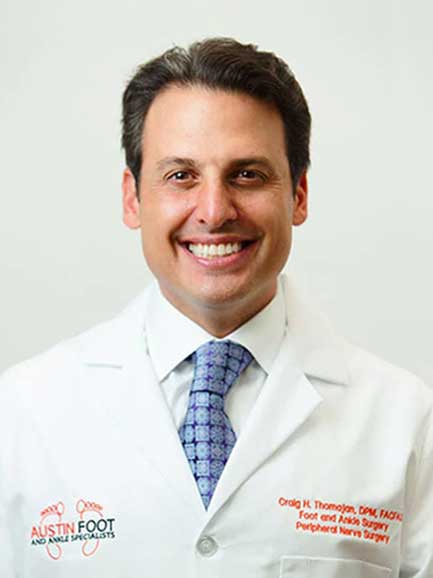
You’ve lived with bunion pain long enough. Maybe it’s the ache that flares up after standing all day, or the sharp discomfort when slipping on your favorite shoes. Surgery has crossed your mind, but traditional bunion surgery—with its long recovery times and risk of recurrence—doesn’t sound appealing. That’s where Lapiplasty comes in, a modern solution designed to correct bunions in a way that keeps you moving and helps prevent them from coming back.
At Austin Foot and Ankle Specialists, Dr. Craig H. Thomajan and his team use Lapiplasty to help patients not just manage their bunions but truly correct them. With advanced training, board certifications, and a commitment to care rooted in compassion and innovation. Here are a few reasons Lapiplasty is changing the future of bunion correction.
A Breakthrough Approach to Bunion Correction
Traditional bunion surgery often focuses on shaving down or cutting the bony bump on the side of the big toe. While this can temporarily reduce the visible deformity, it doesn’t address the root cause: a misalignment of the metatarsal bone in three dimensions. Because the problem isn’t fully corrected, bunions often return.
Lapiplasty bunion treatment takes a fundamentally different approach. Instead of flattening the bump, it rotates the bone back into proper alignment in all three dimensions—up and down, side to side, and front to back. The surgeon then uses titanium plates to secure the joint in its corrected position, reducing the risk of recurrence and giving patients confidence that their results will last.
The Power of 3D Bunion Correction
By realigning the entire bone, Lapiplasty does more than improve appearance—it restores proper function. This 3D correction allows patients to push off naturally when walking, which helps reduce uneven pressure and secondary issues such as hammertoes, calluses, or chronic joint pain.
Imagine a crooked fence post. Shaving down the part sticking out might make it look straighter, but the post is still tilted underground. Lapiplasty resets the post at its foundation, providing lasting stability.
Benefits of 3D correction include:
- Better long-term stability. With the root deformity fixed, the risk of bunions returning drops significantly.
- Natural biomechanics. Because the big toe moves as it should, patients can walk, run, and exercise with less restriction.
- Reduced pain over time. Proper alignment lowers strain on surrounding joints, muscles, and tendons.
- Improved shoe comfort. Correcting the deformity often means patients can wear a broader range of footwear without discomfort.
Faster Recovery and Earlier Return to Activities
One of the most appealing advantages of Lapiplasty is the shorter recovery timeline compared to traditional bunion surgery. Patients can often bear weight in a protective boot within days of surgery, rather than waiting six to eight weeks.
Many return to light activities in a matter of weeks and resume more strenuous exercise within a few months. This accelerated recovery is a game-changer for busy professionals, parents, and active adults.
Why recovery is quicker with Lapiplasty:
- Smaller incisions minimize soft tissue disruption.
- Stable titanium plating reduces the need for extended immobilization.
- Correcting the deformity at its source decreases post-op complications.
- Early mobility helps patients maintain muscle strength and circulation, speeding overall healing.
Preserving Natural Foot Movement
Traditional bunion surgeries sometimes involve cutting or fusing joints, which can limit flexibility and make the foot feel stiff. This loss of motion can affect balance, stride, and even the ability to enjoy simple activities like yoga or hiking.
Lapiplasty preserves the joint while restoring alignment. Patients typically retain natural motion in the big toe, which makes walking, exercising, and wearing different types of footwear more comfortable. Maintaining this natural movement not only improves daily comfort but also reduces the likelihood of future foot problems caused by restricted mobility.
The Role of an Experienced Austin Podiatrist
Choosing the right surgeon is just as important as choosing the right procedure. Dr. Craig H. Thomajan brings board certifications in both foot surgery and reconstructive rearfoot/ankle surgery, along with fellowship recognition from leading professional organizations. This combination of credentials demonstrates not only advanced training but also a commitment to maintaining the highest standards of patient care.
At Austin Foot and Ankle Specialists, patient education is a priority. You’ll never be left wondering what to expect. Your doctor will explain every step—from diagnosis to recovery—with clarity, so you can make informed decisions with confidence. The team’s dedication ensures patients feel supported not just on surgery day, but throughout the entire healing process.
What Patients Can Expect After Lapiplasty
Every recovery journey is unique, but many patients report noticeable improvements in both comfort and mobility within months of surgery. Shoes that once felt impossible to wear fit again. Walking no longer triggers sharp pain. And you experience far less worry about bunions returning.
Some patients even notice improvements beyond the bunion itself, such as reduced ankle or knee strain from better foot alignment. Over time, the cumulative benefits of proper biomechanics can enhance overall mobility and quality of life.
The Lasting Value of Lapiplasty
Bunions are more than cosmetic—they can disrupt daily activity and erode quality of life. Traditional surgery may provide temporary relief, but it often falls short of fixing the underlying problem. Lapiplasty offers something different: a biomechanically sound correction designed to restore both form and function.
With benefits such as 3D bone realignment, preserved natural motion, and faster return to activities, Lapiplasty represents a new standard in bunion care. For many patients in Austin, this innovative approach means not just walking without pain, but walking with confidence into a healthier future.

